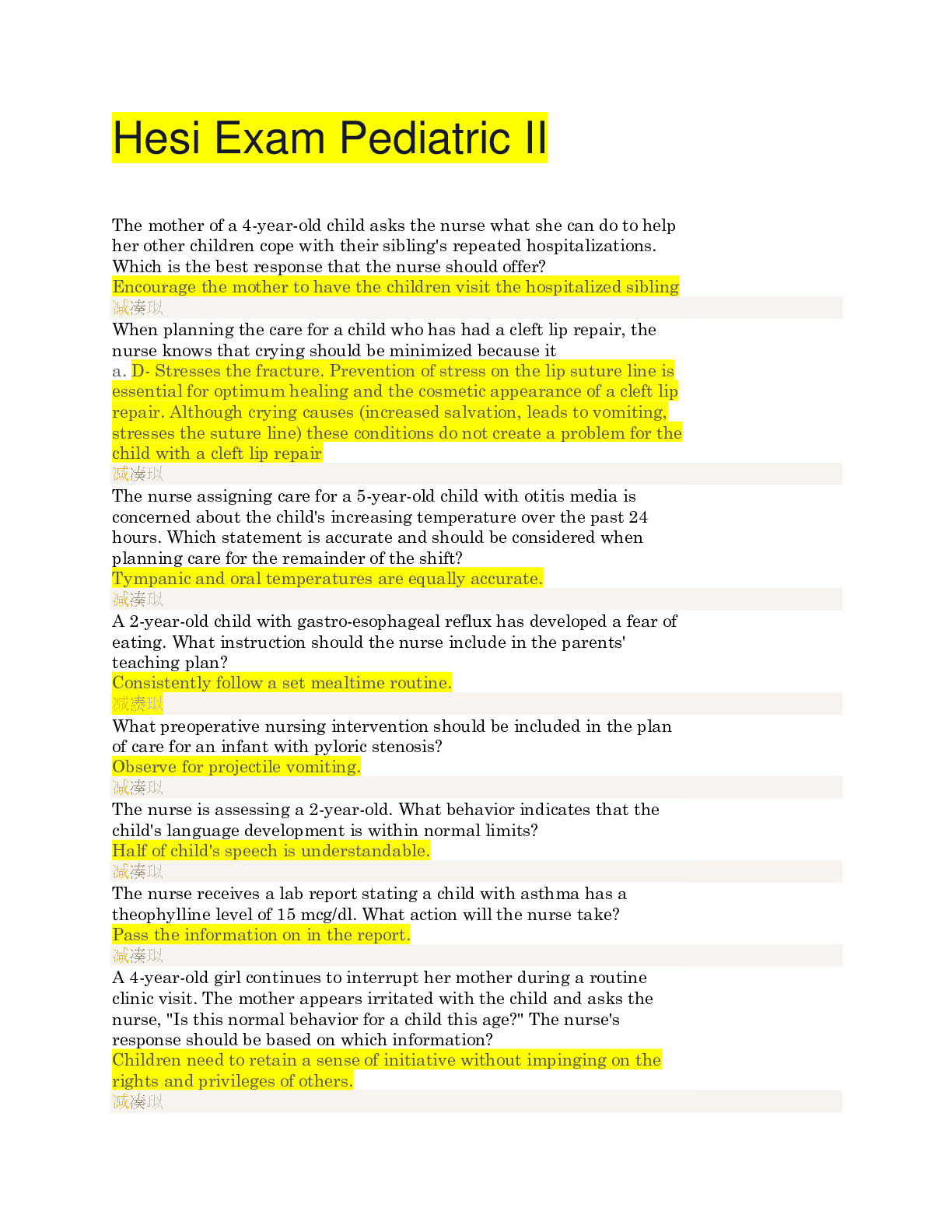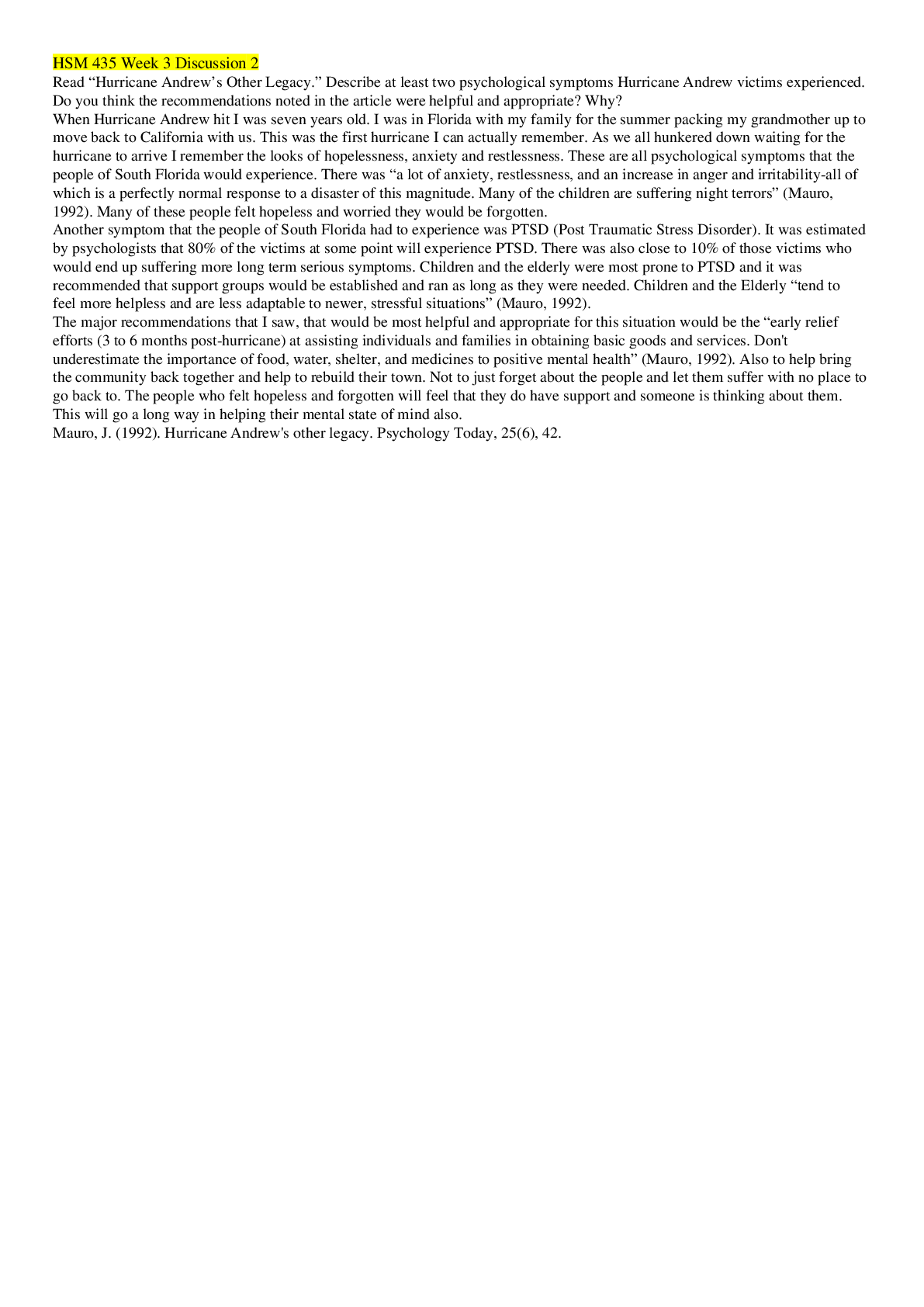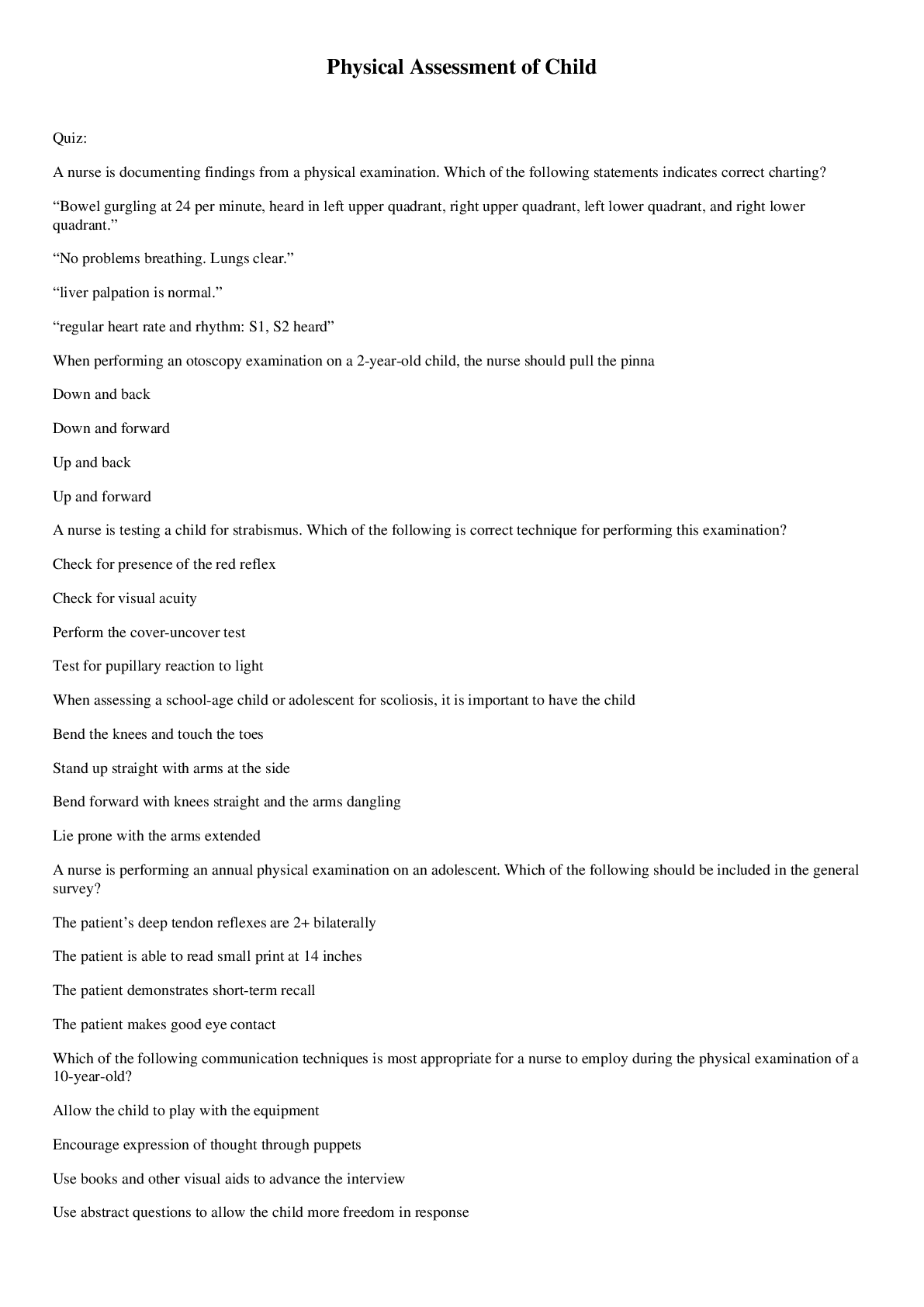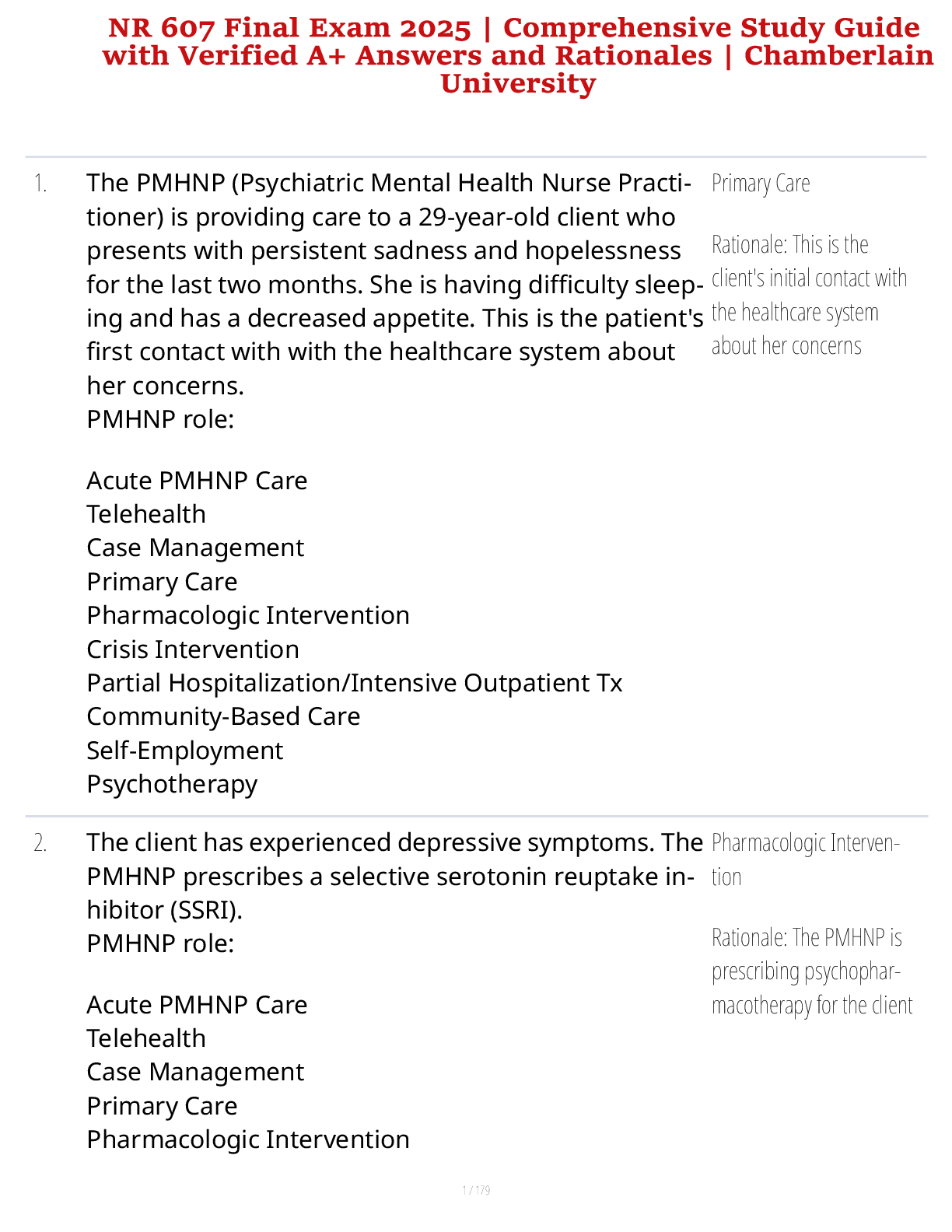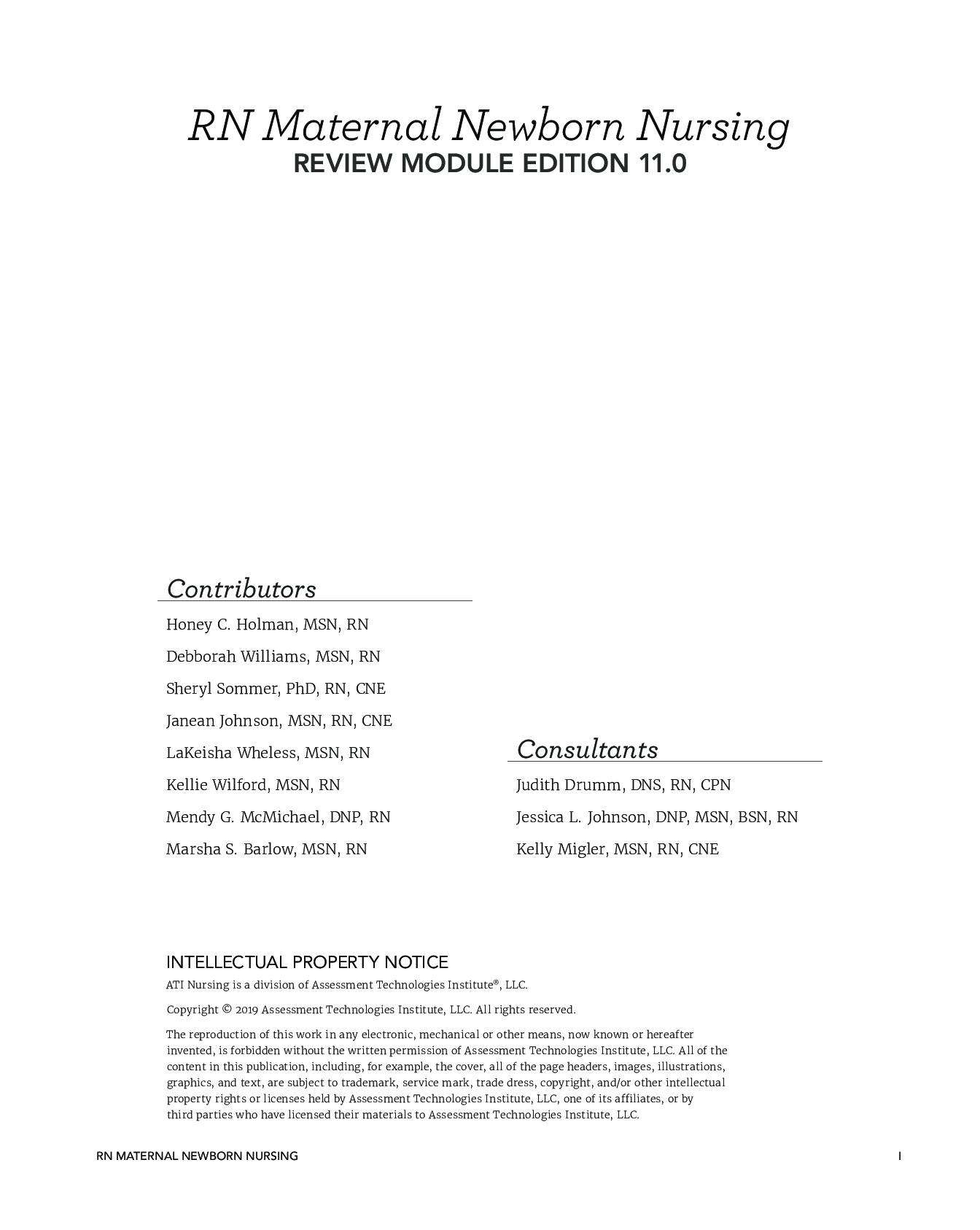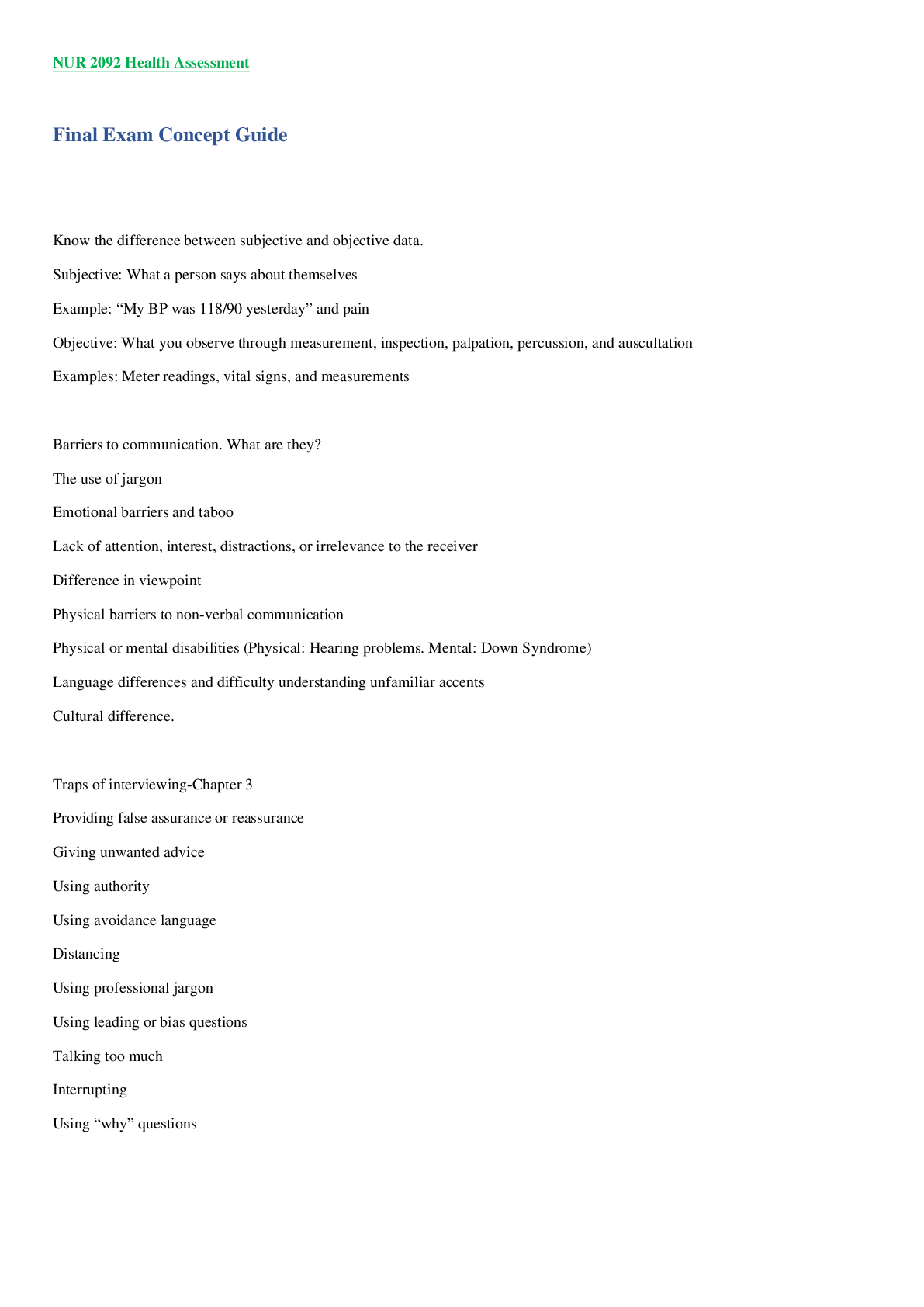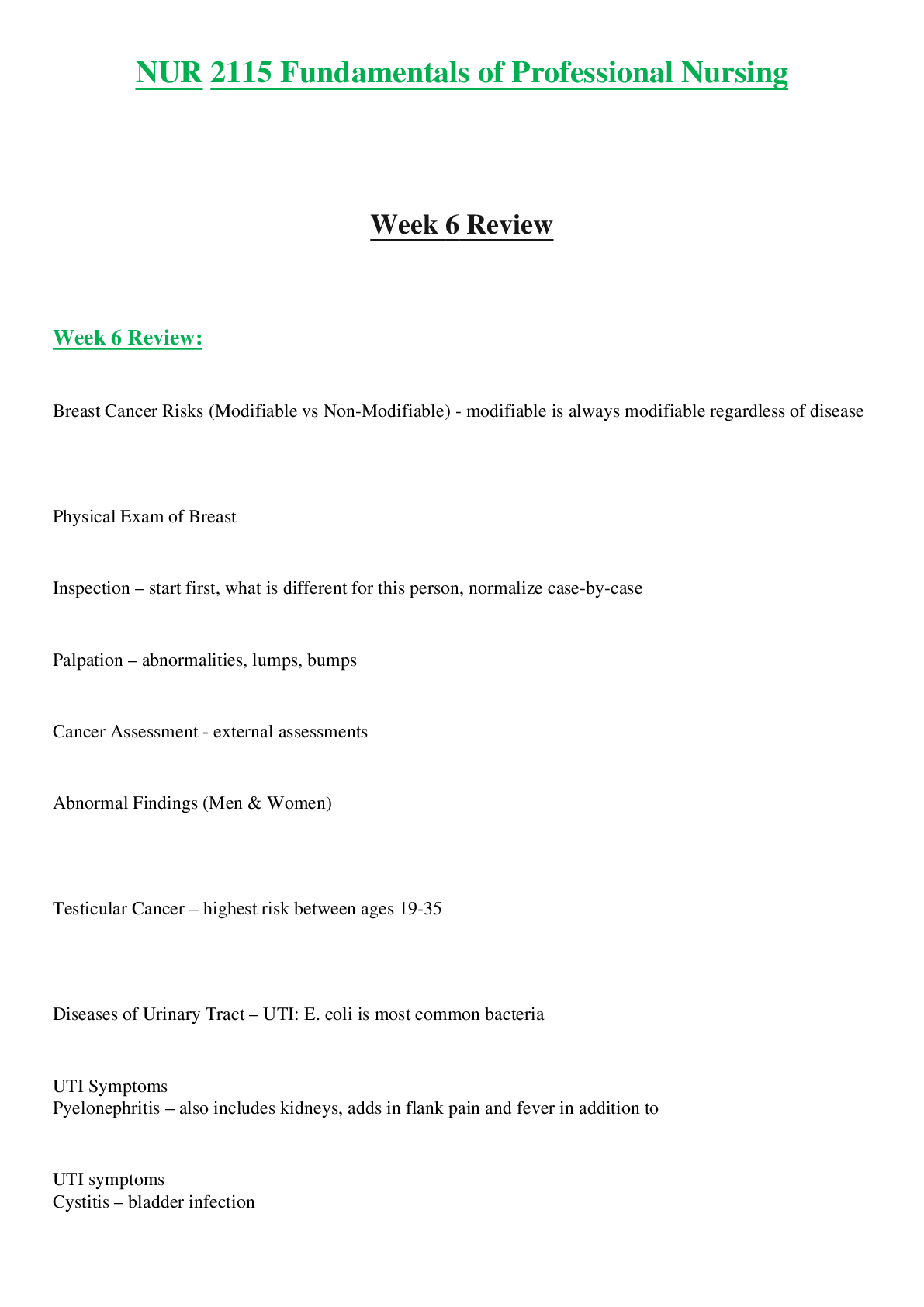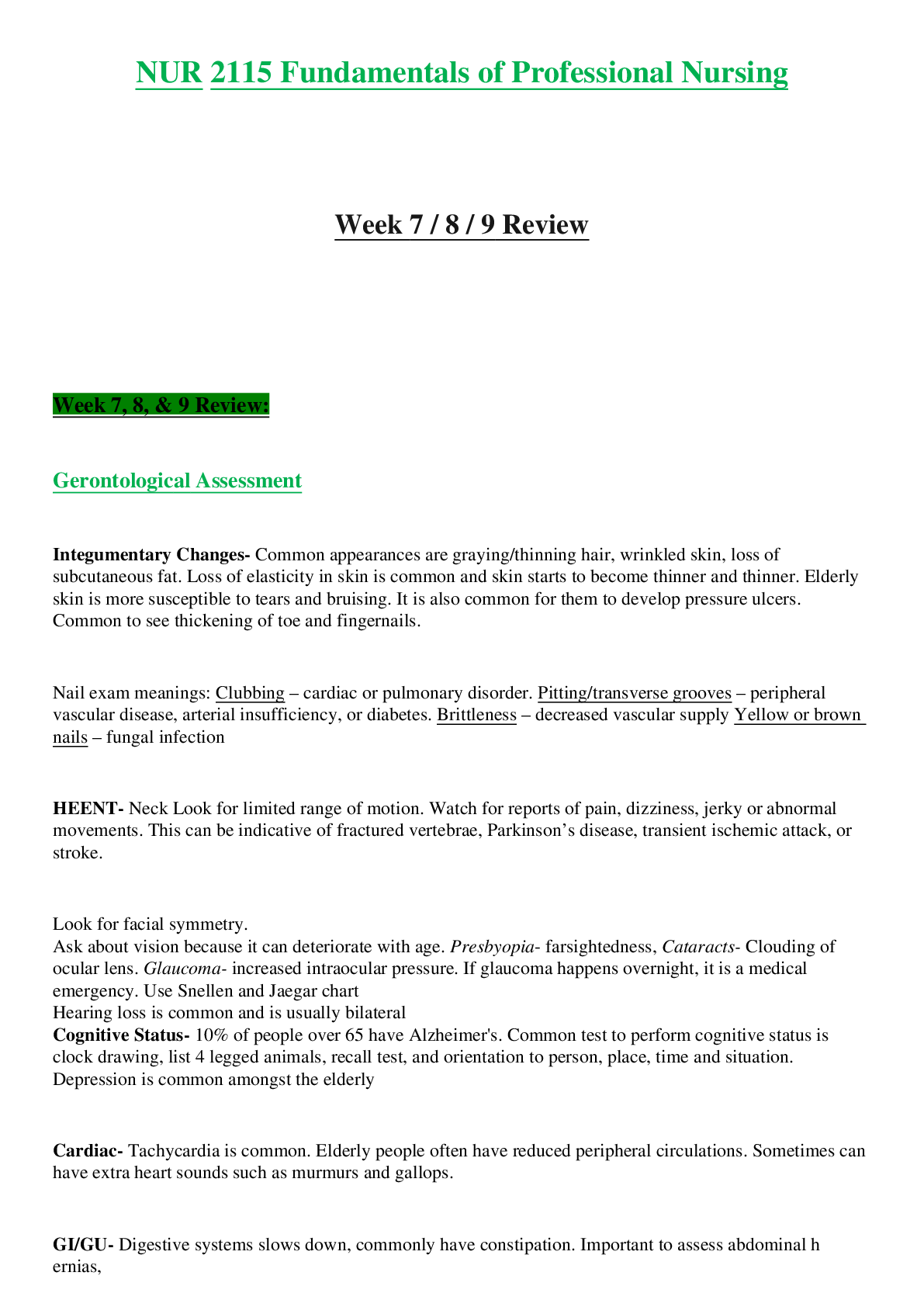General Questions > STUDY GUIDE > SEJPME Module 3 lesson 4 |Complete Solution Guide|Latest 2020 Community College of the Air Force: GR (All)
SEJPME Module 3 lesson 4 |Complete Solution Guide|Latest 2020 Community College of the Air Force: GRADED A
Document Content and Description Below
SEJPME Module 3 lesson 4 ish and on This command diagram highlights the "big picture" of the National Military Command Structure. Notice that the operational chain of command runs directly from the Pr ... esident to the SecDef and then to the Unified or CCDRs. This is a clear and unambiguous line of authority. A goal of Goldwater-Nichols was to "strengthen civilian authority in DoD" and to "place clear responsibility on the commanders of unified and specified commands for the accomplishment of missions assigned and ensure that the authority of those commanders is commensurate with that responsibility...” Note once again, that the CJCS and JCS are not in the operational chain of command. The CJCS provides advice and enhances communication. The Service Chiefs are also clearly not in the operational chain of command between the President, the SecDef, and the CCDRs. Power shifted from the Service Chiefs to the CCDRs as a result of the Goldwater-Nichols Act. The non-operational chain of command runs from the President, through the SecDef, to the Secretaries of the Military Departments. Then, to the degree established by the Secretaries or specified in law, this authority runs through the Service Chiefs to the Service Component Commanders assigned to the CCDRs and to the commanders of forces not assigned to the CCDRs. Services are directed to assign the majority of their forces to the Unified or COCOMs in the Global Force Management Implementation Guidance (GFMIG). Administrative control (ADCON) provides for the preparation of military forces and their administration and support. The Secretaries of the Military Departments are responsible for the administration and support of Service forces. They fulfill their responsibilities by exercising ADCON through the Service Component Commanders assigned to COCOMs and through the Service Chiefs (as determined by the Secretaries) for forces not assigned to the COCOMs such as admin, training, and recruiting units. The responsibilities and authority exercised by the Secretaries of the Military Departments are subject by law to the authority provided to the CCDRs in their exercise of COCOM (Command Authority). Commanders of forces are responsible to their respective Service Chiefs for the administration, training, and readiness of their unit(s). Commanders of forces assigned to the COCOMs are under the authority, direction, and control of (and are responsible to) their CCDR to carry out assigned operational missions, joint training and exercises, and logistics. The United States Coast Guard (USCG) is a military Service and a branch of the Armed Forces of the United States (U.S.) at all times. However, it is established separately by law as a Service in the Department of Homeland Security (DHS), except when transferred to the Department of the Navy (DON) during time of war, or when the President so directs The JCS is comprised of the: • CJCS • Vice Chairman of the Joint Chiefs of Staff (VCJCS) • Chief of Staff, U.S. Army • Chief of Naval Operations • Chief of Staff, U.S. Air Force • Commandant of the Marine Corps, and • Chief of the National Guard Bureau Please click the Resources button at the bottom of your screen to view the organizational structure of the JCS. Select each image to learn more about the functions of the CJCS and the duties of the JCS. Military Departments have administrative and support responsibilities. Subject to the authority, direction, and control of the SecDef and subject to the provisions of Title 10, U.S. Code (USC), the Army, Navy, and Air Force, under their respective Secretaries, are responsible for the functions shown. The Military Services and the United States Special Operations Command (USSOCOM) in areas unique to special operations, share the division of responsibility for developing military capabilities for the COCOMs. USSOCOM is unique among the COCOMs in that it performs certain Service-like functions. For more information on the Military Departments, see Department of Defense Directive (DoDD) 5100.1, Functions of the DoD and Its Major Components, which can be accessed from the Resources link at the bottom of your screen. The President, through the SecDef and with the advice and assistance of the CJCS, establishes combatant (unified) commands for the performance of military missions and prescribes the force structure of such commands. Geographic combatant commanders (GCCs) are assigned a geographic area of responsibility (AOR) by the President with the advice of the SecDef as specified in the Unified Command Plan (UCP). Functional combatant commanders (functionals) have transregional responsibilities. The functionals support GCCs, conduct operations in direct support of the President or the SecDef normally in coordination with the GCC in whose AOR the operation will be conducted, and may be designated by the SecDef as the supported CCDR for an operation. The common functions of a CCDR are shown in the image. For more information on CCDR assigned responsibilities, refer to the UCP or Joint Pub 1, which can be accessed from the Resources link at the bottom of your screen. A combatant command (COCOM) is a unified or specified command with a broad continuing mission. It operates under a single commander who is established and designated by the President, through the Secretary of Defense (SecDef), and with the advice and assistance of the Chairman of the Joint Chiefs (CJCS). This image represents a typical chain of command. Click each button to learn more about the COCOM. [Unified Command] A unified command typically is established when a broad continuing mission under a single commander exists. A unified command is composed of significant assigned components of two or more Military Departments. [Specified Command] A specified combatant command typically is composed of forces from a single Military Department that has a broad, continuing mission and is normally functional. [Unified Command Plan (UCP)] The Unified Command Plan (UCP) defines geographic Areas of Responsibility (AOR) for selected combatant commands, including all associated land, water areas, and airspace. Additional criteria defining the UCP are shown here. [Combatant Commanders (CCDR)] The Combatant Commanders (CCDRs) exercise Combatant Command (COCOM) of assigned forces. They are directly responsible to the President and SecDef for the performance of assigned missions and the preparedness of their commands. Additional information about the role of the CCDR is shown. Unified Command Plan (UCP) 2011 was signed by President Obama on 6 April 2011. It assigns several new missions to the COCOMs. Every two years, the CJCS is required to review the missions, responsibilities, and geographical boundaries of each COCOM. The CJCS then recommends to the President, through the SecDef, any changes that may be necessary. As in past years, the 2011 review process included the COCOMs, Service Chiefs, and DoD leadership. Click the button to learn about the new missions of UCP 2011. When authorized by the SecDef through the CJCS, commanders of unified combatant commands may establish subordinate unified commands (also called subunified commands) to conduct operations on a continuing basis in accordance with the criteria set forth for unified commands. Commanders of subordinate unified commands have functions and responsibilities similar to those of the commanders of unified commands. They exercise Operational Control (OPCON) of assigned commands and forces and normally over attached forces within the assigned joint operations area or functional area. A subordinate unified command may be established on a geographic area or functional basis. Roll over the button to view examples of subordinate unified commands The purpose of a Joint Task Force (JTF) is to accomplish missions with specific, limited objectives which do not require overall centralized control of logistics When we use the term Joint Force Commander (JFC), we are referring exclusively to a combatant commander, subordinate unified commander, or joint task force commander. The preceding pages were devoted to these joint force commands. Now, we will discuss component command options beginning with Service component commands. All JFCs have Service components because administrative and logistic support for joint forces is provided through the Service component commands. JFCs may conduct operations through the Service component commanders or, at lower echelons, Service force commanders. The other component command option is Functional component commands. A Joint Force Commander may decide to establish Functional component commands to conduct operations when forces from two or more Military Departments must operate within the same mission area or geographic domain or there is a need to accomplish a distinct aspect of the assigned mission. Command is central to all military action, and unity of command is central to unity of effort. Inherent in command is the authority that a military commander exercises over subordinates, including authority to assign missions and accountability for their successful completion. Although commanders may delegate authority to accomplish missions, they may not absolve themselves of the responsibility for attainment of these missions. Authority is never absolute; the extent of authority is specified by the establishing authority, directives, and law. The specific command relationship will define the level of authority a commander has over assigned or attached forces. It is important that you understand these levels of authority Assignment of Forces] All forces under the jurisdiction of the Secretaries of the Military Departments (except those forces necessary to carry out the functions of the Military Departments) are assigned to combatant commands (COCOM) by the Secretary of Defense (SecDef). [Transfer of Forces] A force assigned or attached to a combatant command may be transferred from that command to another Combatant Commander only when directed by the SecDef, under procedures prescribed by the SecDef, and approved by the President. The command relationship that the gaining commander will exercise (and the losing commander will relinquish) will be specified by the SecDef. [Assigned Forces] The Combatant Commander (CCDR) exercises COCOM over forces assigned by the President or SecDef. Forces are assigned when the transfer of forces will be permanent or for an unknown period of time, or when the broadest level of command and control (C2) is required or desired. Operational Control (OPCON) of assigned forces is inherent in COCOM and may be delegated within the combatant command by the Combatant Commander. Subordinate joint force commanders will exercise OPCON over assigned forces. [Attached Forces] The CCDR normally exercises OPCON over forces attached by the SecDef. Forces are attached when the transfer of forces will be temporary. Establishing authorities for subordinate unified commands and joint task forces normally will direct the delegation of OPCON over forces attached to those subordinate commands. Several key characteristics of COCOMs are that they: • Have full authority to organize and employ assigned forces • Have directive authority for logistics and joint training • Are not transferable, and • Require unified Specified commanders only Several key characteristics of OPCONs are that they: • Are exercised by commanders at or below Combatant Command level • Have authoritative direction for military operations and joint training, and • They are limited in that they have no inherent authority for logistics, discipline, admin, internal organization, or unit training Several key characteristics of TACONs are that they: • Are inherent in OPCON, and • Have detailed local direction and control of movements or maneuvers within the operational area necessary to accomplish assigned missions or tasks Support is a command authority. A support relationship is established by a superior commander between subordinate commanders when one organization should aid, protect, complement, or sustain another force. Support may be exercised by commanders at any echelon at or below the combatant command level. This includes the SecDef designating a support relationship between Combatant Commanders as well as within a combatant command. The designation of supporting relationships is important as it conveys priorities to commanders and staffs that are planning or executing joint operations. The support command relationship is, by design, a somewhat vague but very flexible arrangement. The establishing authority, who is the common superior commander, is responsible for ensuring that both the supported commander and supporting commanders understand the degree of authority that the supported commander is granted. The supported commander should ensure that the supporting commanders understand the assistance required. There are four defined categories of support that a Combatant Commander may direct over assigned or attached forces to ensure the appropriate level of support is provided to accomplish mission objectives. These include: • General support • Mutual support • Direct support, and • Close support The graphic shown here summarizes each of the categories of support. The establishing directive will specify the type and extent of support that the specified forces are to provide. For example, land forces that provide fires normally are tasked in a direct support role. Authorities outside the command relationship include administrative control, coordinating authority, and direct liaison authorized. Competent joint force commanders must be skilled in thinking strategically and at optimizing joint capabilities, applying strategic and operational art, and having a joint perspective. There are five values that have special impact on the conduct of joint operations. The values are integrity, competency, physical courage, moral courage, and teamwork. Our troops deserve the best leadership we can provide. Command is the most important function undertaken by a joint force commander. Select the image to hear Oliver North talk about today's youth serving in uniform. [Video] The average age of the young American serving in uniform today is twenty and a half years of age. Making him about ten months older than his grandfather, who would have served in my war. He is a high school graduate. He is a volunteer. He is brighter, better educated, better trained, led, and equipped than any Soldier, Sailor, Airman, Guardsman, or Marine of any country in history. He goes to work wearing an eight pound Kevlar helmet, a forty five pound flak jacket, and today in Kandahar it was a hundred and ten degrees, and he will hike up those hills and walk back down them without complaining. He has been taught chemistry, and physics, and ballistics, and avionics, and electronics to operate and maintain the most sophisticated weapons and equipment ever designed by the hand and mind of man. He can use his body like a weapon, and his weapon like part of his body. He can take a life, or save one because he has been so remarkably well trained. The images of the young Marines, and Soldiers, and Sailors, and Airmen going to Bible studies and religious services aren't staged. They are all real. They are all spontaneous, and nearly all of them are initiated by those young Americans in harm's way. When they gather in prayer circles and huddle up before a mission, they are not going out to play football. They are going into mortal combat. And they know that some of them are not liable to come back. And they do it because they have faith. Just for grins, how many of you raised a teenage boy? I used to do this when Betsy wasn't there because she eventually told me "I saw you raise your hand and I, I did that!" Think about getting a teenage boy to clean up his own room, do his own laundry, fix his own meals. Clean up everything without a size ten in the back side. And yet that same youngster, TODAY, washes and mends his own clothing, feeds himself, takes care of cleaning his weapon, cleaning himself. He is totally self-sufficient. The kid, who once wouldn't share a candy bar with his little brother, now gives away his last drop of water to a wounded comrade, his only MRE to a hungry Afghan kid, and splits his ammo with a mate in a firefight. I always save this one for last, when I am explaining it to young people about who they are. Because so few of them know the truth of these youngsters. This is a frame taken from my footage on the sixth of April, two thousand and three. Bagdad is the smoke pall you see in the background. The marine unit I am with, embedded, is the van, the lead element of the attack of the eastern corridor. We are about fifteen miles outside of Bagdad and a Republican Guards regiment ambushes this Marine Rifle Company. They spin their Humvees around, and there is a gunfight that occurs between this regiment and this rifle company. And in the midst of the beaten zone, the area where the intersecting bullets are crossing, a United States Navy Corpsman, I had first met in Kandahar, in two thousand and one, rushes into the battle field. Right through the fire, drags two wounded Marines out, and carries them on his shoulder to a helicopter that has landed in the roadway. And in this footage right here, I am standing on the ramp of that helicopter. And this Corpsman, who has rushed now twice before and brought these two wounded back, now has a third one. And off to the right hand side, as you look at the screen, a Reuters news crew sets up their tripod. And they are videotaping him going in and out. And as this guy staggers back into the gunfight, one of them shouts out, "Hey Mate! What did you do that for? Didn't you notice," in another words, you stupid American, "didn't you notice that wasn't a Marine?" If you look carefully at that photograph, you will see that the wounded warrior, who's already been bandaged up by that United States Navy Medical Corpsman, isn't a Marine. It is a wounded Iraqi soldier. And THIS U.S. Navy Corpsman has rushed into the battlefield to save HIS life. And so, because it is polite company, Wayne, I can only put it this way... In response to the Reuters news crew, the Navy Corpsman gives them a "gesture". You are not supposed to, you're not supposed to get that part. He gives them a gesture and he says "Didn't you notice? He was wounded? That's what we do, we're AMERICANS." The Armed Forces fulfill unique and crucial roles, defending the United States (U.S.) against all adversaries and serving the Nation as a bulwark and the guarantor of its security and independence. When called to action, the Armed Forces support and defend national interests worldwide. The Armed Forces embody the highest values and standards of American society and the profession of arms. The Armed Forces serve under the civilian control of the President who is the Commander in Chief. The primary reference for this lesson was Joint Pub 1, Doctrine for the Armed Forces of the United States, 25 March 2013. Click each button to review the information covered in the lessons of this module. When you are finished, click the Next Lesson tab at the top of the page to continue. [Lesson 2] The purpose of this lesson was to familiarize you with the U.S. national military command structure. It specified the national chain of command and command relationships and authorities. This lesson provided an introduction to joint doctrine, the twelve principles of joint operations, the context of irregular warfare, and the instruments of national power (DIME). It also included fundamental principles and guidance for command and control, the exercise of military authority, and organizing joint forces. [Lesson 3] You learned about the national military command structure. The President and SecDef exercise authority and control of the Armed Forces through two distinct branches of the chain of command. The operational branch runs from the President, through the SecDef, to the CCDRs for missions and forces assigned to their commands. The non-operational branch runs from the President through the SecDef to the Secretaries of the Military Departments. The lesson covered the functions of the CJCS, Vice Chairman of the Joint Chiefs of Staff (VCJCS), the Joint Staff, Military Departments, and CCDRs. [Lesson 4] This lesson reviewed several different options for organizing joint forces to include: • Combatant commands (COCOMs) • Subordinate unified commands • Joint task forces • Service component commands, and • Functional component commands [Lesson 5] Finally, it covered joint command and control. We learned that CCDRs exercise COCOM command authority over assigned forces. Subunified commanders and Joint Task Force (JTF) commanders exercise Operational Control (OPCON) of joint forces. Other authorities such as Tactical Control (TACON), Support, Administrative Control (ADCON), Coordinating Authority, and Direct Liaison Authority (DIRLAUTH) were also presented The purpose of the Interagency Coordination Module is to provide you with an understanding of how successful interagency coordination contributes to national goals across the spectrum of levels. In particular, you will understand how agencies other than the U.S. Department of Defense (DoD) contribute to the achievement of the military commander's mission and objectives. You will learn why non-DoD agencies should take into account State Department foreign policy goals and the views of U.S. ambassadors and their Country Teams. Additionally, you should also understand how a Combatant Commander and his staff work with State Department and Embassy officials. Material from this Interagency Coordination Module will prepare you for future seminar planning efforts and for humanitarian exercises such as PURPLE HOPE, PURPLE GUARDIAN, and PURPLE ECLIPSE. As you work through the module lessons, you will learn more about: • The challenges in working toward unity of effort in joint, interagency, and intergovernmental planning • The organization of the National Security Council System and its role in shaping national security strategy • The challenges in training a joint, interagency, intergovernmental, and multinational capability through your analysis and application of interagency coordination principles to a given scenario, and • The benefits of joint, interagency, intergovernmental, and multinational efforts in an operation to achieve unity of effort • While military operations tend to depend more on structure and doctrine, the interagency process often is described as "more art than science." • Unity of effort can only be achieved through close, continuous interagency coordination and cooperation, which are necessary to overcome discord, inadequate structure and procedures, incompatible communications, cultural differences, and bureaucratic and personnel limitations. • Interagency coordination is the cooperation and communication that occurs between agencies of the United States Government, including the Department of Defense (DoD), to accomplish an objective. • Similarly, in the context of DoD involvement, the term interagency coordination expands to include coordination between not only elements of DoD and other governmental agencies (OGAs), but also intergovernmental organizations (IGOs) and nongovernmental organizations (NGOs) to achieve an objective. • The interagency process facilitates unity of effort by military and nonmilitary participants conducting interagency coordination in pursuit of national objectives. • To accomplish these objectives, the national security strategy--as shown in the graphic--guides the coordination of the instruments of national power. • The National Security Council (NSC) is the principal policy-making forum responsible for national security strategy. • The NSC system is a process to coordinate executive departments and agencies in the effective development and implementation of national security policies. This coordination sets the stage for strategic guidance provided to the combatant commands, Services, and various DoD agencies, and forms the foundation for operational and tactical-level guidance. • Click the Relevance button to learn more about the relationship between the NSC and Combatant Commanders. • It is vital for the Combatant Commander to know what occurs in the interagency process at the strategic level, especially in the NSC, because the most important decisions on whether to intervene in a crisis and about political-military planning for post-conflict are made within that forum. • The National Security Advisor is responsible for mediating and brokering disagreements among cabinet heads with the objective of achieving a single viewpoint that can be presented to the President for decision. • In summary, the NSC, including the National Security Advisor, is not a mini-State Department, but, rather, an honest broker when cabinet members disagree on a key issue • The Strategic Level in the interagency process takes place at the national level, "inside the Beltway" of Washington, D.C. • The players at the national level are representatives from the DoD and Joint Staff who will sit down at conference tables with representatives from other U.S. agencies. • The relevance of the interagency process at the strategic level to the Combatant Commander and the U.S. military is that the process yields America's major national security policy decisions. For example, will we intervene in Kosovo? What will U.S.China policy be What role will the U.S. play in East Timor? What will our national counterterrorism strategy be (after September 11, 2001)? • It also yields integrated political-military planning. For instance, how will the U.S. address the challenges with North Korea or Iran? Another example would be determining who will lead stability operations in Afghanistan. • To view the details of the agencies involved at this level, see Figure 1-1 in JP 3-08, Interorganizational Coordination During Joint Operations, by selecting the Resources button at the bottom of the screen. *****Contunued (100 pages)******************************* [Show More]
Last updated: 3 years ago
Preview 1 out of 1 pages
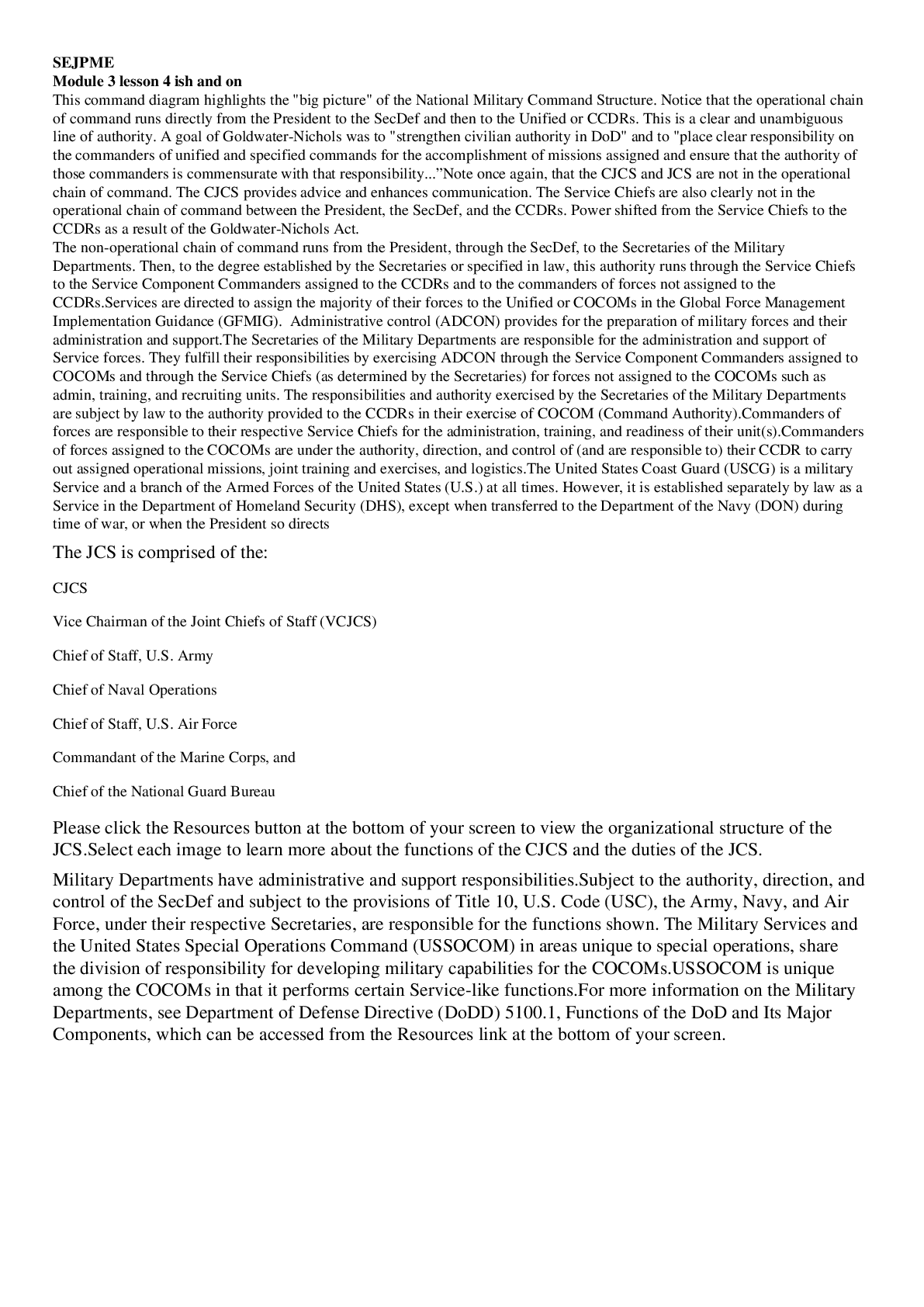
Buy this document to get the full access instantly
Instant Download Access after purchase
Buy NowInstant download
We Accept:

Reviews( 0 )
$20.00
Can't find what you want? Try our AI powered Search
Document information
Connected school, study & course
About the document
Uploaded On
May 26, 2020
Number of pages
1
Written in
All
Additional information
This document has been written for:
Uploaded
May 26, 2020
Downloads
0
Views
140





